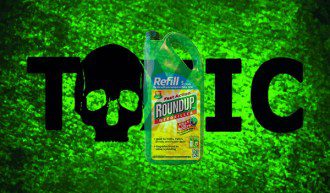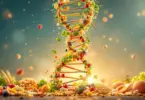October 20th, 2016
Guest writer for Wake Up World
Glyphosate, the active ingredient in Monsanto’s Roundup herbicide, recently earned the ominous title of the most heavily-used agricultural chemical of all time.[1] In fact, an analysis showed that farmers sprayed enough glyphosate in 2014 to apply 0.8 pounds of the chemical to every acre of cultivated cropland in the U.S., and nearly 0.5 pounds of glyphosate to all cropland worldwide.
As you might suspect, when you use this much of a chemical, it doesn’t simply stay on the fields. Laboratory testing commissioned by the organizations Sustainable Pulse and Moms Across America revealed that glyphosate is now showing up virtually everywhere — in vaccines and even in breast milk.
Monsanto’s ‘Gift’ to Newborns
The analysis revealed glyphosate in levels of 76 µg/L to 166 µg/L in women’s breast milk. As reported by The Detox Project, this is 760 to 1,600 times higher than the EU-permitted level in drinking water (although it’s lower than the U.S. maximum contaminant level for glyphosate which, controversially, is 700 µg/L.) [2]
[pro_ad_display_adzone id=”110028″]
This dose of glyphosate in breastfed babies’ every meal is only the beginning. An in vitro study designed to simulate human exposures also found that glyphosate crosses the placental barrier. In the study, 15 percent of the administered glyphosate reached the fetal compartment.
Angelika Hilbeck, Ph.D., senior scientist at the Institute of Integrative Biology in Zurich, told The Detox Project:[3] “If confirmed in a full investigation, it seems that glyphosate has become a ubiquitous chemical in terms of presence and persistence. This data also offers a first indication of potential accumulation in the human body, giving newborns a substantial dose of synthetic chemicals as a ‘gift’ for their start into life, with unknown consequences. This is reckless and irresponsible conduct in a democratic society, which still has a living memory of previous reckless chemical contaminations, such as DDT.”
Glyphosate Found in Blood and Urine Samples
The analysis revealed glyphosate in additional samples as well, including the blood of non-pregnant Canadian women. Their average level was 73.6 µg/L, which is similar to the concentration found to have endocrine-disrupting effects in vitro.
Further, glyphosate was also detected in urine samples, and U.S. women had maximum glyphosate levels that were more than eight times higher than levels found in urine of Europeans.
Where is the glyphosate exposure coming from? It’s likely coming from food (although it could be in water as well). We don’t know exactly how much glyphosate may be in your food because the U.S. Department of Agriculture (USDA) does not test for it.
The U.S. Food and Drug Administration (FDA) just announced in February 2016 that it would begin testing foods for glyphosate, however, which will help to quantify just how much glyphosate Americans are consuming.
For now, the analysis suggests that eating non-organic, genetically engineered (GE) foods (the prime candidates for Roundup spraying) is associated with higher glyphosate levels in your body. The Detox Project explained:[4]
Glyphosate levels have been found to be significantly higher in urine of humans who ate non-organic food, compared with those who ate mostly organic food. Chronically ill people showed significantly higher glyphosate residues in their urine than healthy people.
In a separate detailed analysis, glyphosate was found in the urine of cows, humans, and rabbits. Cows kept in a GM-free area had significantly lower glyphosate concentrations in urine than cows in conventional livestock systems.
Glyphosate is Contaminating Air and Water
Glyphosate and its degradation product, aminomethylphosphonic acid (AMPA), were detected in more than 75 percent of air and rain samples collected during the 2007 growing season in the Mississippi Delta agricultural region.[5]
This could be even higher now, as since 1996 the use of glyphosate has risen nearly 15-fold.[6] The testing commissioned by Moms Across America also found glyphosate in 13 of 21 U.S. drinking water samples tested.[7]
They contained glyphosate levels between 0.085 ug/l and 0.33 ug/l, which is only slightly below the EU maximum allowed level for glyphosate in drinking water of 0.1 ug/l. The U.S. Environmental Protection Agency (EPA) standard for glyphosate in U.S. water supplies is 0.7 ppm.
Further, a 2012 analysis used a magnetic particle immunoassay to test for the presence of glyphosate in roughly 140 samples of groundwater from Catalonia, Spain. The analysis found that glyphosate was present above the limit of quantification in 41 percent of the samples.
This suggests the chemical does not break down rapidly in the environment, as its manufacturer claims, and instead it might be accumulating (both in the environment and in people).
Groundwater, which is water from rain, lakes, streams or other bodies of water that soaks into soil and bedrock, can easily become contaminated when chemicals in the soil with low biodegradability and high mobility empty into it.
When groundwater is used as a drinking water source, this contamination poses a risk to animals, plants and humans alike.
Glyphosate is Sprayed on Some Crops Right Before Harvest
In northern, colder regions, farmers of wheat and barley must wait for their crops to dry out prior to harvest.
Rather than wait an additional two weeks or so for this to happen naturally, farmers realized they could spray the plants with glyphosate, killing the crop and accelerating their drying (a process known as desiccating).
Desiccating wheat with glyphosate is particularly common in years with wet weather and has been increasing in North Dakota and Upper Midwestern states in the U.S., as well as in areas of Canada and Scotland (where the process first began). One Canadian farmer told EcoWatch:[8]
I think every non-organic farmer in Saskatchewan uses glyphosate on most of their wheat acres every year … I think farmers need to realize that all of the chemicals we use are ‘bad’ to some extent …
Monsanto has done such an effective job marketing glyphosate as ‘safe’ and ‘biodegradable’ that farmers here still believe this even though such claims are false.
What this means is that even non-GE foods are likely to be contaminated with glyphosate, and possibly even more so because they’re being sprayed just weeks prior to being made into your cereal, bread, cookies and the like.
Many Crops Are Desiccated With Glyphosate, a ‘Barbaric’ Process
Along with wheat and oats, other crops that are commonly desiccated with glyphosate include:
| Lentils | Peas | Non-GMO soybeans |
| Corn | Flax | Rye and buckwheat |
| Triticale | Canola | Millet |
| Sugar beets | Potatoes | Sunflowers |
No one is keeping track of how many crops are being desiccated with glyphosate; those in the industry have described it as a “don’t ask, don’t tell policy.”
Others have described spraying crops with glyphosate just days before harvest “barbaric.” Charles Benbrook, Ph.D., a researcher involved in the recent study showing glyphosate use is increasing,[9] told EcoWatch:[10]
It may be two percent of agriculture use, but well over 50 percent of dietary exposure … I don’t understand why Monsanto and the food industry don’t voluntarily end this practice. They know it contributes to high dietary exposure (of glyphosate).
European Union Puts Off Decision to Renew Use of Glyphosate
European Commission leaders met in early March 2016 to vote on whether to renew a 15-year license for glyphosate, which is set to expire in June. The decision has been tabled for now amid mounting opposition. More than 180,000 Europeans signed a petition calling for glyphosate to be banned. They cited the International Agency for Research on Cancer’s (IARC) determination that glyphosate is a “probable carcinogen” (Class 2A).
[pro_ad_display_adzone id=”110030″]
This determination was based on evidence showing the popular weed killer can cause non-Hodgkin’s lymphoma and lung cancer in humans, along with “convincing evidence” it can also cause cancer in animals. The opposition comes amidst another new report that found 75 percent of the German population has glyphosate residue in their urine.
The majority of those tested had levels that were five times higher than the legal limit of drinking water, while one-third had levels that were between 10 and 42 times higher than the legal limit.[11] A study of glyphosate residues by the Munich Environmental Institute also found glyphosate in 14 best-selling German beers.[12]
Monsanto CEO Caught Lying
In a Twitter conversation with Monsanto, TriplePundit said they hoped to gain a “constructive conversation” and “build some bridges with an organization that has a lot of power and opportunity to do good.”[13] In the conversation, Monsanto’s CEO Hugh Grant claimed the company’s position on GMO labeling may be shifting, stating:
The myth is that we’re against labeling. The reality is we would support some kind of federal standard. We would support something that covers the country, that helps consumers. Our concern has been the danger of a state-by-state labeling approach that resulted in confusion and expense.
As TriplePundit reported, however, it’s no “myth” that Monsanto is against such labeling:[14]
This statement is somewhat at odds with Monsanto’s website, last updated in 2013: ‘We oppose mandatory labeling of food and ingredients developed from GM seeds in the absence of any demonstrated risks, as it could be interpreted as a warning or imply that food products containing these ingredients are somehow inferior to their conventional or organic counterparts.
Monsanto Spends Millions to Prevent GMO Labeling Initiatives
Monsanto has spent millions to defeat GMO labeling initiatives, so you won’t know which foods contain their genetically modified organisms (GMOs). In 2013, the company donated nearly $5 million to the anti-labeling campaign in Washington State, and in 2012 they donated more than $7 million to help defeat California’s Proposition 37. In total, Monsanto has spent at least $22 million in lobbying against state-level GMO labeling initiatives.[15]
Together with the food and industrial agriculture industries, biotechnology companies like Monsanto spent more than $101 million on lobbying to avert GMO labeling and preempt state rights, and that was in 2015 alone.[16]
They may feel defeat is near, as such lobbying efforts have risen sharply. For instance, these industries spent $66 million on such lobbying efforts in 2014 and just over $25 million in 2013.[17] They are trying to HIDE the presence of genetically engineered ingredients and are pulling out ALL the stops to do so.
Health Risks of Glyphosate
Glyphosate has a number of devastating biological effects beyond being a probable carcinogen, including the following:
| Nutritional deficiencies, as glyphosate immobilizes certain nutrients and alters the nutritional composition of the treated crop | Disruption of the biosynthesis of aromatic amino acids (these are essential amino acids not produced in your body that must be supplied via your diet) |
| Increased toxin exposure (this includes high levels of glyphosate and formaldehyde in the food itself) | Impairment of sulfate transport and sulfur metabolism; sulfate deficiency |
| Systemic toxicity — a side effect of extreme disruption of microbial function throughout your body; beneficial microbes in particular, allowing for overgrowth of pathogens | Gut dysbiosis (imbalances in gut bacteria, inflammation, leaky gut, and food allergies such as gluten intolerance) |
| Enhancement of damaging effects of other food-borne chemical residues and environmental toxins as a result of glyphosate shutting down the function of detoxifying enzymes | Creation of ammonia (a byproduct created when certain microbes break down glyphosate), which can lead to brain inflammation associated with autism and Alzheimer’s disease |
How to Avoid Pesticides in Your Food
Your best bet for minimizing health risks from pesticide exposure is to avoid them in the first place, by eating organic as much as possible and investing in a good water filtration system for your home or apartment. If you know you have been exposed to pesticides, the lactic acid bacteria formed during the fermentation of kimchi may also help your body break down pesticides.
So including fermented foods like kimchi in your diet may also be a wise strategy to help detox the pesticides that do enter your body. One of the benefits of eating organic is that the foods will be free of GE ingredients — and this is key to avoiding exposure to toxic glyphosate. Following are some great resources to obtain wholesome organic food.
Eating locally-produced organic food will not only support your family’s health, it will also protect the environment from harmful chemical pollutants and the inadvertent spread of genetically engineered seeds and chemical-resistant weeds and pests.
Article references: see below.
About the author:
 Born and raised in the inner city of Chicago, IL, Dr. Joseph Mercola is an osteopathic physician trained in both traditional and natural medicine. Board-certified in family medicine, Dr. Mercola served as the chairman of the family medicine department at St. Alexius Medical Center for five years, and in 2012 was granted fellowship status by the American College of Nutrition (ACN).
Born and raised in the inner city of Chicago, IL, Dr. Joseph Mercola is an osteopathic physician trained in both traditional and natural medicine. Board-certified in family medicine, Dr. Mercola served as the chairman of the family medicine department at St. Alexius Medical Center for five years, and in 2012 was granted fellowship status by the American College of Nutrition (ACN).
While in practice in the late 80s, Dr. Mercola realized the drugs he was prescribing to chronically ill patients were not working. By the early 90s, he began exploring the world of natural medicine, and soon changed the way he practiced medicine.
In 1997 Dr. Mercola founded www.Mercola.com, which is now routinely among the top 10 health sites on the internet. His passion is to transform the traditional medical paradigm in the United States. “The existing medical establishment is responsible for killing and permanently injuring millions of Americans… You want practical health solutions without the hype, and that’s what I offer.”
Visit Mercola.com for more information, or read Dr. Mercola’s full bio and résumé here.
Recommended articles by Dr. Mercola:
- The Biggest Cause of Anxiety and Depression is Traumatic Life Events
- Zika: Brazil Admits It’s Not the Virus
- Plants Are Smarter Than You Think
- How the War on Drugs Has Caused More Harm Than Good
- The One Size Fits All Vaccination Schedule is Not Safe for Every Child
- Scientific Links Between Processed Foods and Depression
- How Sugar Harms Your Brain Health and Drives Alzheimer’s Epidemic
- The Health Benefits of Intermittent Fasting
- Can a Hug a Day Keep Infection Away?
- Fluoride Deception Continues: US Government Ignores Fluoride’s Role as an Endocrine Disruptor
- Magnesium: An Invisible Deficiency That Could Be Harming Your Health
- Medical Errors: Still the Third Leading Cause of Death
- The Magic Healing Power of Mushrooms
- The Science of Healing Thoughts
Article References
- [1] Newsweek February 2, 2016
- [2], [3], [4] The Detox Project
- [5]Environ Toxicol Chem. 2014 Jun;33(6):1283-93.
- [6],[9] Environmental Sciences Europe February 2, 2016
- [7] Moms Across America April 7, 2014
- [8],[10] EcoWatch March 5, 2016
- [11] EurActiv Germany March 6, 2016
- [12] Bloomberg March 10, 2016
- [13],[14],[15] TriplePundit March 9, 2016
- [16],[17] Environmental Working Group February 25, 2016
- The Detox Project
- EcoWatch March 5, 2016
- Common Dreams March 7, 2016
- Bloomberg March 10, 2016
- TriplePundit March 9, 2016
[pro_ad_display_adzone id=”110027″]







